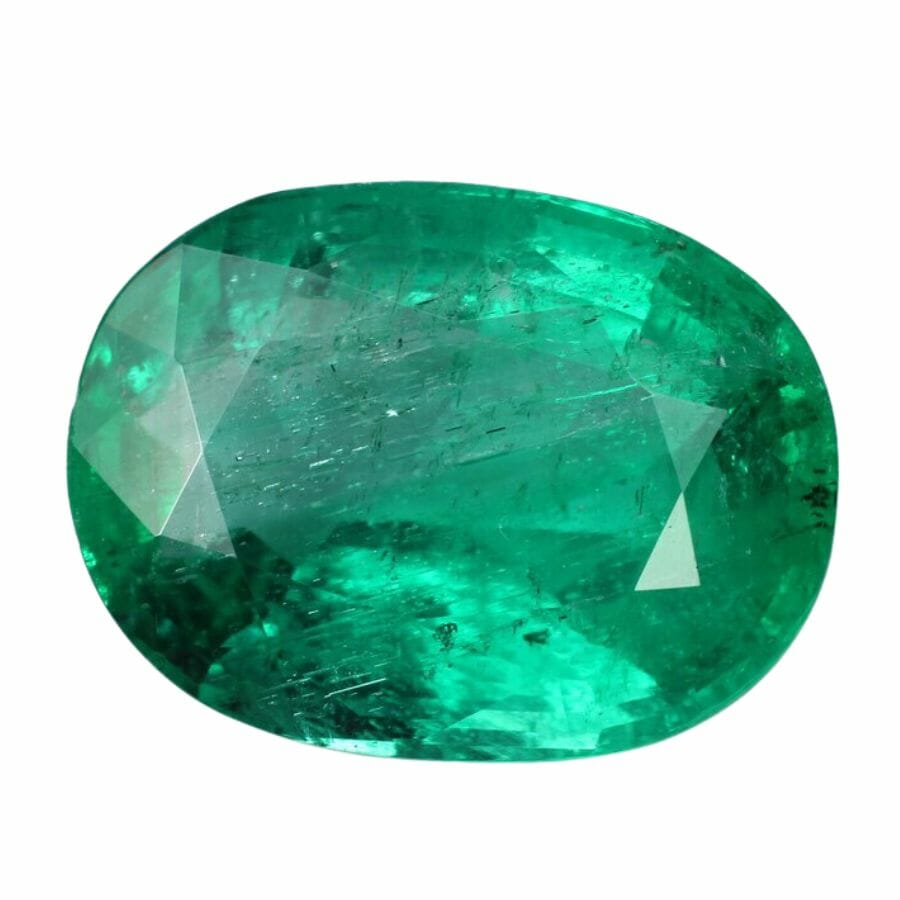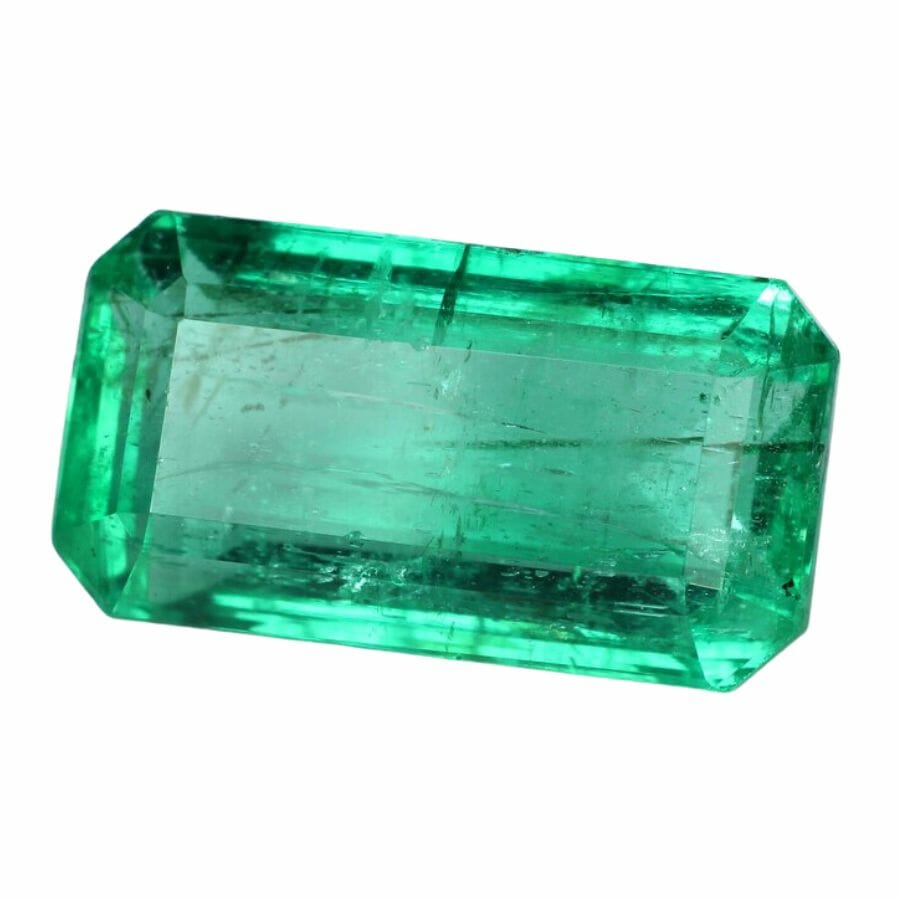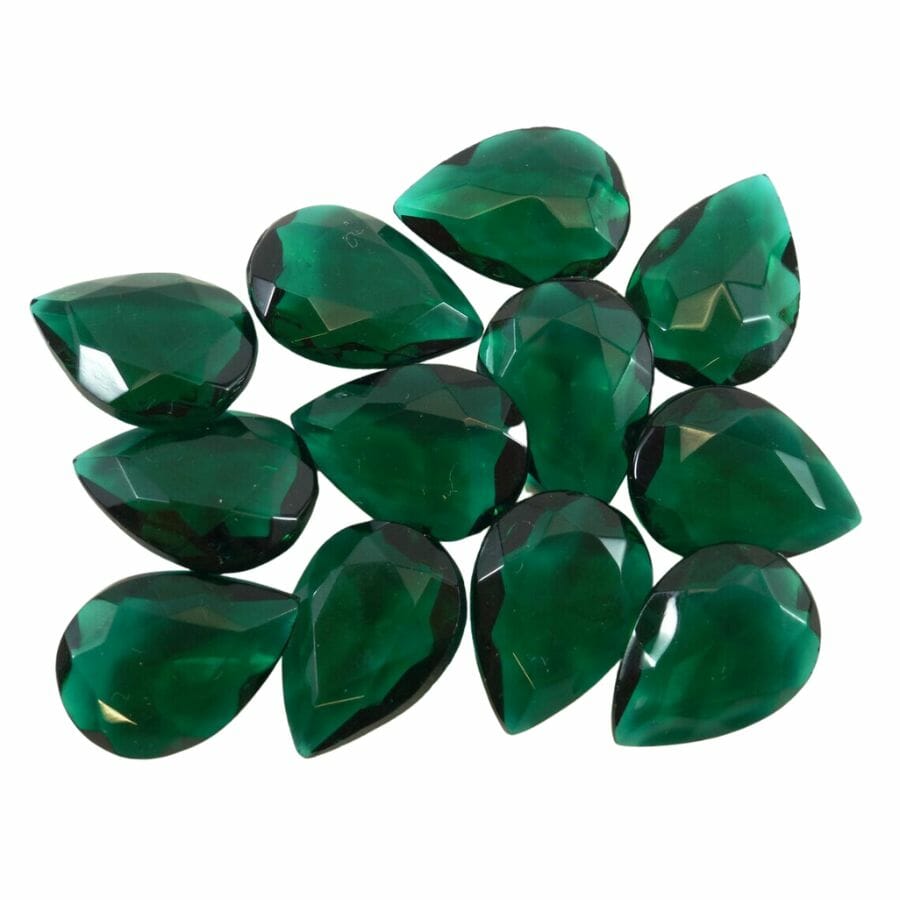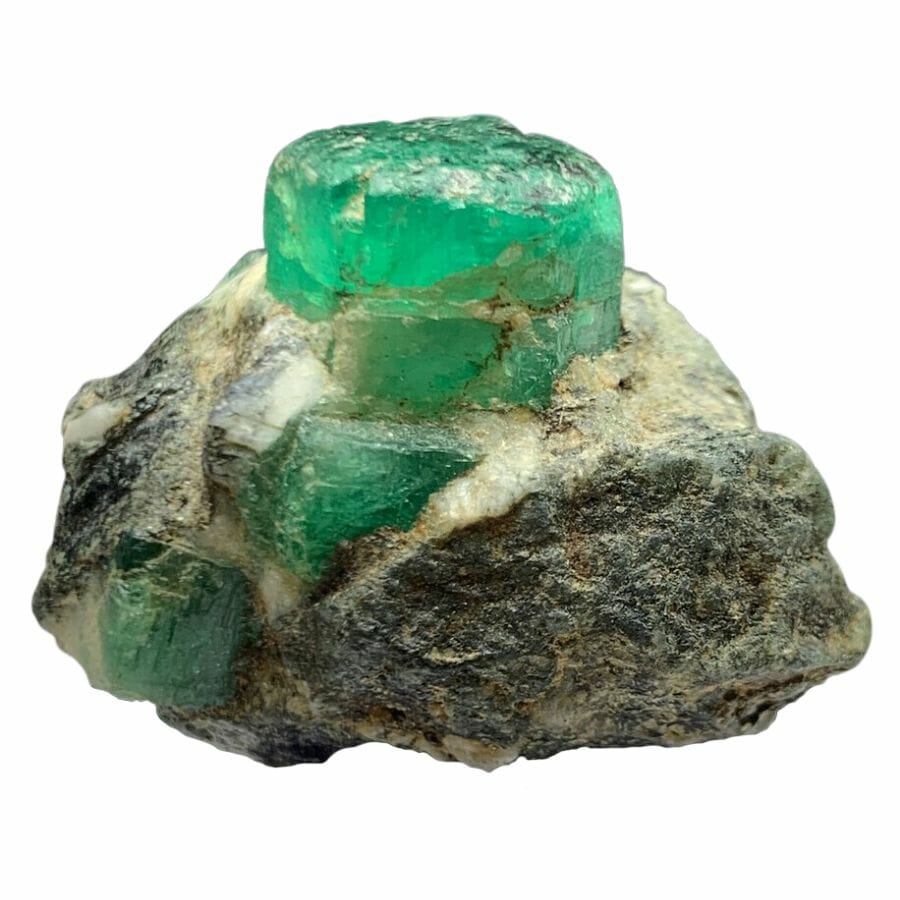Emeralds are stunning green gems loved by many for their vibrant color and allure. However, not all emeralds are genuine. Some are made in labs, and others are clever imitations.
Knowing how to identify emeralds is a valuable skill. This knowledge will protect buyers, collectors, and enthusiasts from being misled or disappointed.
Just like a trained detective looks for specific clues to solve a case, there are clear signs to watch for when determining if an emerald is real or not. With a little insight, anyone can become adept at spotting the real deal.
Understanding Natural Emeralds and Why Fakes Are Common

Emeralds belong to the beryl family of minerals. The rich green color of emeralds comes from tiny amounts of chromium and vanadium in their structure.
These gems form deep within the Earth’s crust, under high pressure and temperature. Over time, magma carrying these minerals rises, cools, and solidifies, allowing emeralds to grow.
Emeralds have some unique properties that make them stand out. They’re softer than diamonds but are still quite durable, making them perfect for jewelry. However, because of their softness, they can get scratched easily.
Many emeralds also have internal flaws called inclusions, which are like tiny birthmarks inside the gem. These inclusions can sometimes make the emerald look cloudy, but they also give each stone a unique character.
People love using emeralds in jewelry like rings, necklaces, and earrings. They’ve been used as symbols of wealth, power, and love. Many cultures treasure emeralds and believe they bring good fortune and health.
Emeralds are valuable not only because of their beauty but also because of their rarity. Finding a high-quality emerald without many inclusions can be difficult, making such gems highly sought after and expensive.
This value, combined with their rich history and stunning appearance, ensures emeralds remain a favorite among gem enthusiasts and collectors.
Why you’re seeing more fake emerald these days
Because of the high demand and the value of emeralds, some people try to make quick money by selling fakes. Advances in technology have made it easier to create convincing imitations that resemble real emeralds.
These synthetic or lab-grown emeralds are cheaper to produce than mining genuine emeralds from the earth. Sellers can then offer these fakes at a lower price, tempting buyers who might think they’re getting a deal.
Sadly, this can lead buyers to mistakenly think they have a genuine emerald when they don’t. It’s always essential to be cautious and informed when buying gems.
How To Identify Real Emerald
Because of the popularity and value of emeralds, the market often sees imitations that try to mimic the beauty of the real thing.
It’s essential for buyers and collectors to arm themselves with knowledge to distinguish between genuine and counterfeit stones.
While some synthetic emeralds are obvious to the trained eye, others can be quite convincing. Rock identification is a skill that dives deep into understanding the unique characteristics of each stone.
There are several techniques and signs to look for, ensuring the gem in your possession is the real deal. With this knowledge, you’ll gain insight into the clear markers and tests that set real emeralds apart from their deceptive counterparts.
Evaluate the stone’s color

To test the color and ensure the gem is genuine, you can follow a few straightforward steps.
First, observe the gem under natural light. Genuine emeralds will show a vibrant green hue. While shades might differ from deep to light green, they never look washed out or overly bright like neon.
If the emerald looks too pale, it might not be real.
Another critical point is to notice any yellow or deep blue tones. Real emeralds might display a bluish-green color or some tinges of yellow, but they shouldn’t lean heavily towards blue or yellow.
Additionally, using a jeweler’s loupe, a small magnifying glass, helps in observing the color consistency throughout the gem. Any abrupt color changes or layers might indicate gem treatments or that the gem isn’t genuine.
Look for inclusions

Inclusions are natural marks or imperfections inside gems. Genuine emeralds have these unique characteristics, which can help determine their authenticity. These tiny flaws are like fingerprints, giving each emerald its identity.
When inspecting for inclusions, using a jeweler’s loupe or a magnifying glass can be handy. Look for small lines, branches, or web-like patterns inside the stone. These patterns show the emerald’s natural growth over time.
It’s worth noting that fake emeralds might also have inclusions, but they often appear different, more like bubbles or unnatural patterns.
On the other hand, if an emerald looks too perfect without any inclusions, there’s a chance it might be glass or another imitation.
Check the stone’s surface temperature

Emeralds are natural insulators, which means they don’t heat up or cool down quickly. Genuine emeralds feel cool against the skin, even if the environment around them is warm.
This cool sensation is a good sign of the gem’s authenticity.
On the contrary, fake emeralds, especially those crafted from glass or plastic, don’t have this insulating property. They tend to adjust rapidly to the surrounding temperature.
So if a supposed emerald warms up quickly in the hand or feels like it’s the same temperature as the room right when picked up, there’s a chance it might be an imitation.
Using the temperature test is a simple yet effective method to help discern real emeralds from fakes.
Test the stone’s hardness

The Mohs scale measures the hardness of minerals, with diamond at the top as the hardest. Emeralds rank below diamonds, which means they’re not as tough. Even though they’re durable, they can still get scratches.
To test an emerald’s hardness, some professionals use a scratch test with minerals of known hardness.
For regular folks, a basic understanding is that if the gem gets scratched super easily or shows signs of wear that’s unusual for its age, it might be a softer imitation.
Authentic emeralds require careful handling to prevent damage, so if you come across a stone that’s touted as an emerald and seems impervious to all wear and tear, it could be a sign that it’s not the real deal.
Look for evidence of oil treatment

The flaws in emeralds can show that the stone is real. But sometimes, people use oil to make these flaws less visible. This makes the emerald look clearer and more perfect.
One way to see if an emerald has been treated with oil is to look for tiny bubbles inside the stone. These bubbles can show where the oil was added.
Now, just because an emerald looks clear and doesn’t have many visible flaws doesn’t mean it’s fake. It could be a genuine emerald that has been treated with oil to make it look better.
So, it’s always good to check and know more about the emerald you are looking at.
The Different Types Of Fake Emeralds And What They Look Like
Some emerald fakes are made in labs, designed to closely mimic the real gem’s properties. Others are different green gemstones or even colored glass, merely posing as emeralds.
We’ll explore the range of fake emeralds, shedding light on their appearance and how they differ from the real deal.
Glass Imitations

Glass imitation emeralds mimic the appearance of the real gem without the associated cost.
Manufacturers create this by mixing regular glass materials with green coloring. Once combined, this mixture is melted and shaped to resemble the form and shine of genuine emerald stones.
After cooling, these pieces of green glass are cut and polished, just like real gemstones would be. With the bright finish and the vivid color, they can look convincing to those not familiar with genuine emeralds.
Jewelers and sellers might use these in jewelry, especially in pieces that are sold at a lower price. However, this fake emerald doesn’t have the same value, durability, or unique characteristics as a natural emerald.
How you can identify glass imitations being sold as real emeralds
Hardness test
On the Mohs hardness scale, emeralds rank between 7.5 to 8, making them relatively hard. Glass imitations, however, are softer, often ranking around 5.5. One clear method to differentiate is by testing the gem’s resistance to scratches.
Using a steel pin, which is harder than glass but softer than emerald, one can gently attempt to scratch the gem’s surface. If it scratches effortlessly, it’s likely a glass imitation rather than a genuine emerald.
Weight
Emeralds and glass have different densities, which affects their weight. Genuine emeralds have a higher density than common glass.
When holding a cut and polished stone, if it feels suspiciously light for its apparent size, there’s a possibility it might be glass. This weight difference is due to the unique atomic structure of emerald compared to glass.
Comparing the weight of a suspected emerald with a known emerald of similar size can provide more clarity in differentiation.
Temperature feel
Emeralds, being natural minerals, have the ability to retain coolness for an extended period. When touched, a genuine emerald should feel cool, even if it’s in a warm environment.
Glass, on the other hand, tends to adapt to ambient temperature more rapidly.
When picking up a gem, if it reaches room temperature swiftly or doesn’t have that initial cool sensation, there’s a good chance it’s a glass imitation rather than an authentic emerald.
Lab-created Emeralds

Lab-created or synthetic emeralds are made by scientists in controlled environments. Instead of waiting for nature to form them over millions of years, these emeralds are grown in a matter of weeks or months.
The process begins by taking the same materials found in natural emeralds, like beryl, chromium, and vanadium.
These are mixed together and placed in special machines that recreate the high-pressure and high-temperature conditions deep within the Earth where genuine emeralds form. Over time, these materials grow into large crystals.
Once grown, these crystals are cut and polished to look like natural emeralds. While they share many of the same properties as natural emeralds, lab-created emeralds often have fewer flaws and a more consistent color.
They can be used in jewelry and sold at a lower price than natural emeralds. However, it’s essential for buyers to know they are getting a lab-created gem, as they typically have a different value than natural ones.
How you can identify lab-created emeralds being sold as real emeralds
Perfection
Emeralds, being products of nature, often display internal imperfections. In contrast, lab-created emeralds are often produced under controlled conditions aiming for perfection.
This results in a crystal that can appear too flawless, lacking the natural marks and inclusions commonly found in genuine stones.
When examining an emerald, an overly clear and immaculate appearance might suggest it’s lab-created rather than a product of nature.
Inclusions
Emeralds, whether natural or lab-created, often contain internal marks known as inclusions. However, the nature of these inclusions can provide clues to the stone’s origin.
Natural emeralds typically exhibit random inclusions, often described as a “garden” due to their organic appearance. In contrast, lab-created emeralds tend to have growth lines or patterns that appear more uniform and structured.
Price
Natural emeralds, being rare, tend to be more expensive, especially if they are of high quality. In contrast, lab-created emeralds are made under controlled conditions, leading to a more abundant supply and a lower cost.
When shopping for emeralds, an extremely attractive price, especially for a stone claimed to be of top quality, could hint at its lab-created origin. Being informed about pricing trends can aid in making educated choices.
Emerald Doublet

An emerald doublet is an assembled gem that’s designed to look like a full emerald but costs less. To make one, two layers of different materials are glued together.
The top layer, the one you can see when set in jewelry, is a thin slice of genuine emerald.
This gives the appearance of the rich green color people expect from an emerald. The bottom layer, hidden underneath, is made of a cheaper, green material like glass or colored stone. Together, these two layers look like one larger emerald.
Jewelers use doublets to offer beautiful jewelry pieces at more affordable prices. However, it’s vital for buyers to understand they’re getting a doublet and not a solid emerald, as the value and durability can differ.
How you can identify emerald doublets being sold as real emeralds
Edge inspection
Doublet emeralds are crafted by fusing two pieces: a genuine emerald on top and another material beneath. When inspecting the gem’s edges, one can often spot a distinct boundary or seam indicating the point of fusion.
This clear line differentiates a doublet from a solid, natural emerald, which won’t display such a separation. Careful observation, especially along the perimeter of the stone, can reveal this telltale sign and help determine the gem’s authenticity.
Transparency test
To differentiate a doublet from a natural emerald, one effective method is examining its transparency. When held against a light source, an emerald doublet might reveal a noticeable change in how light travels through it.
There could be a distinct change or division in light passage, particularly at the junction of the two bonded materials. This hints at the gem’s composite nature.
Weight and feel
Doublets can have a distinct weight and feel compared to solid emeralds. When handling the gem, pay attention to its heft.
Genuine emeralds have a specific density, giving them a characteristic weight for their size. Doublets, with their mixed materials, might deviate from this expected weight.
Comparing the gem’s feel with a confirmed emerald can provide hints about its authenticity.
Green Cubic Zirconia

Green cubic zirconia is a man-made gemstone designed to look like many different precious stones, including emeralds. To make this gem, scientists use a blend of zirconium dioxide and other minerals.
By adding specific green colorants to the mix, they can produce a stone that closely resembles the vibrant green hue of a natural emerald. This mixture is then heated until it becomes molten. Once it cools and hardens, large crystals form.
These crystals are cut and polished to shine brightly, just like genuine gemstones. When used in jewelry, green cubic zirconia offers a beautiful look at a more affordable price.
However, while they might look similar, it’s essential to know the difference between cubic zirconia and a natural emerald in terms of value and properties.
How you can identify green cubic zirconia being sold as real emerald
Brilliance and sparkle
The brilliance of emeralds is often more subdued compared to some other gems. Green cubic zirconia, on the other hand, is known for its intense sparkle and light reflection.
This gem can emit a dazzling array of bright sparkles, which can easily set it apart from a genuine emerald.
When observing a stone, if its brilliance and fire seem exceptionally vivid, it might be indicative of green cubic zirconia rather than a natural emerald.
Hardness
Emeralds are softer gems. Cubic zirconia, in contrast, has a higher hardness, typically around 8.5. This difference in hardness can be a clue in identification.
If a gem looks like it doesn’t have much damage or wear and tear, it’s a sign that it might be green cubic zirconia and not a genuine emerald.
Inclusions
Green cubic zirconia, created in controlled laboratory settings, tends to be much cleaner and free of inclusions compared to natural emeralds.
The absence of these natural markings, especially in a gem that’s exceptionally clear, can be a telltale sign that it’s not a genuine emerald but rather a piece of green cubic zirconia.
Green Dyed Quartz

Dyeing quartz green is another method used to imitate the look of emeralds. Quartz is a common, clear mineral. To make it look like emerald, the quartz is placed in a solution with green dye.
Over time, the dye seeps into the quartz, giving it a green color.
Once dyed, the quartz can be cut and polished to resemble a genuine emerald. This process is cost-effective, allowing manufacturers to produce lots of green stones quickly.
Jewelry made with green dyed quartz is often cheaper than those made with real emeralds. However, there’s a drawback. Over time and with exposure to sunlight or certain chemicals, the dye can fade, and the stone might lose its vibrant color.
How you can identify green dyed quartz being sold as real emerald
Color fading
Prolonged exposure to environmental elements like sunlight or contact with chemicals can cause the green dye in the quartz to deteriorate.
If observing a stone reveals areas of uneven coloration or apparent fading, it’s a clear indication that the gem might be a piece of green dyed quartz and not a genuine emerald.
Surface stains
Green dyed quartz can sometimes reveal its true nature at the surface. The dyeing process isn’t always perfect, and the quartz might exhibit uneven coloration.
Notably, certain spots or patches may appear blotchy or overly saturated with dye, standing out against the rest of the gem. Observing such surface inconsistencies can hint that the stone is likely dyed quartz and not an authentic emerald.
Reaction to heat
When heated, the dye in the quartz can become unstable, leading to color changes or revealing previously concealed dye patterns.
Observing a stone’s reaction to heat, such as a color shift or evidence of dye, can serve as a clue that one might be dealing with dyed quartz rather than a genuine emerald.
How To Tell If an Emerald Is Real Vs Fake
To safeguard your investments and passions, it’s essential to discern genuine emeralds from counterfeits. As we delve deeper, we’ll spotlight key indicators and methods that can help indicate if a stone is a genuine emerald or not.
How To Identify a Fake Emerald When It’s Cut Or Polished
Emeralds are often transformed into cut and polished gems to enhance their beauty. However, this transformation can also mask the true nature of a stone, making it harder to differentiate genuine emeralds from impostors.
When these gems are given a polished finish, they shimmer and gleam, but beneath that shine lies the tale of their authenticity.
Fortunately, there are telltale signs and methods that distinguish real cut and polished emeralds from their deceptive counterparts.
Inspect inclusions

Inclusions in genuine emeralds often resemble little branches, webs, or clouds. These tell-tale signs show the stone’s natural growth and formation over thousands of years.
However, in fake or lab-created emeralds, inclusions might appear too uniform or have a pattern that seems arranged. This is because the conditions in a lab are controlled, leading to more predictable inclusion patterns.
Furthermore, some fake emeralds might not have any inclusions at all, appearing too perfect. So, when buying an emerald, a closer look at its inclusions, using a magnifying glass or jeweler’s loupe, can give valuable clues about its authenticity.
Price evaluation

Price is often a clear sign when trying to figure out if you’re holding a real or fake emerald. Genuine emeralds are quite valuable. They’re rare and people love them for their stunning green color.
So, if you find an emerald that’s being sold at a super cheap price, that’s a warning sign. It’s like finding a brand new car for the price of a bicycle. It just doesn’t add up.
Knowing how to tell if an emerald is real can save you from spending money on something that isn’t worth it. Always check the going price for genuine emeralds and be wary of deals that seem too good to be true.
Assess the brilliance

When assessing an emerald, consider the way it interacts with light. A real emerald has a rich and deep shine but doesn’t have the same fiery brilliance or dispersion as some other gemstones.
On the other hand, many imitation stones, crafted to mimic the appearance of a natural emerald, might be designed to sparkle more intensely to catch the eye.
This can make them look more attractive at first glance, but it’s not a characteristic of a genuine emerald.
How To Identify a Fake X When It’s Raw
Before emeralds are cut and polished, they exist in a rough state, and distinguishing genuine raw emeralds from fakes becomes paramount for collectors and buyers.
These are the distinct characteristics and signs that help in recognizing a true raw emerald, ensuring that you can confidently differentiate between authentic and deceptive stones.
Feel for temperature

Emeralds, like many natural gemstones, have the distinctive property of retaining coolness longer than their surroundings. When trying to determine real vs fake emerald, one method involves assessing these properties.
This characteristic can be a useful tool in identifying genuine emeralds from fakes, even when they are uncut. When you pick up an emerald, it should feel notably cold, and it will take some time for it to reach the temperature of your hand.
On the other hand, materials like glass or plastic used to mimic emeralds can warm up almost immediately upon contact. This is because these materials don’t have the same thermal conductivity as the real thing.
So, if you’re examining a raw stone and it doesn’t have that initial cold feel or if it warms up too rapidly, there’s a good chance it’s not a genuine emerald.
Texture and feel

Real emeralds have unique characteristics due to their natural formation. Their surface might be a bit grainy or rugged.
On the other hand, many fakes, especially those made from glass or other materials, will have a slick or very smooth feel to them.
Touch can be a significant clue. Running fingers over the stone and feeling for any irregularities can help in determining its authenticity.
It’s always good to trust your tactile senses; if the stone feels too polished or unnaturally smooth, there’s a chance it’s not a genuine emerald.
Test hardness

Emeralds are pretty durable and resistant to scratches. In comparison, softer materials like glass or some imitations might get scratched easily.
So, when handling a raw stone that’s believed to be an emerald, try a simple scratch test. If you find that common items leave marks or gouges in the stone, it’s a red flag. Genuine emeralds should resist light scratching.
Remember, while they’re hard, emeralds can still be brittle, so always handle with care.

